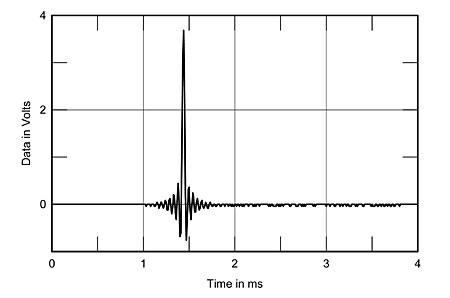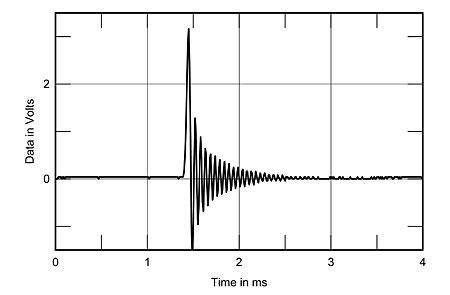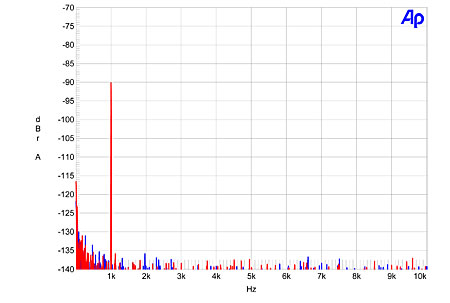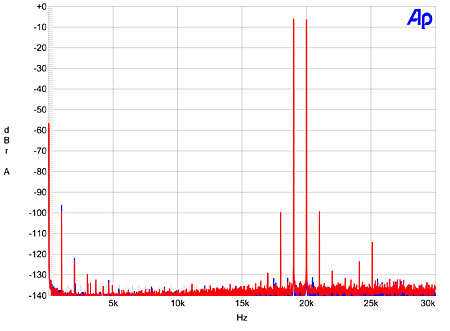| Columns Retired Columns & Blogs |
Meridian 808.2/808i.2 Signature Reference CD player/preamplifier Measurements
Sidebar 3: Measurements
I examined the measured behavior of the Meridian 808i.2 Signature Reference using the Audio Precision SYS2722 system (see www.ap.com and "As We See It" in the January 2008 issue), as well as, for some tests, our Audio Precision System One and the Miller Audio Research Jitter Analyzer. For this review, I looked only at the Meridian's performance as a CD player/digital processor. Its measurements as a preamplifier will be included in the Follow-Up discussed in the main body of the review.
With the Meridian set to operate as a player with a fixed output, its maximum output level at 1kHz was 4.7V from its balanced XLR jacks, 2.36V from its single-ended RCA jacks, both outputs preserving absolute polarity; ie, they were non-inverting. With the variable output-level control active, the maximum level before clipping with a full-scale1kHz digital signal was 6.62V with the volume control set to "87." The control operated in accurate 1dB steps, meaning that, as the maximum setting is "99," there is up to 12dB of gain available, though this won't be usable playing CDs or with external PCM data.
The balanced source impedance was a low 94 ohms, and, as expected, exactly half that value from the single-ended outputs. Error correction, judged using the Pierre Verany Test CD, was excellent, there being no glitches in the Meridian's output until the gaps in the data spiral reached 2mm in length.
To examine the behavior of the Meridian's "apodizing" reconstruction filter, I created a 44.1kHz-sampled test signal comprising a pair of positive single-sample pulses spaced approximately 5ms apart. The first pulse of the pair triggered my digital oscilloscope, which I'd set to "one-shot" mode so that the player's reaction to the second pulse appeared in the center of the 'scope's display. (The 'scope lacks an anti-aliasing filter; provided sufficiently fast sampling is used, it accurately displays time-domain data without obscuring those data with its own impulse response.)
Fig.1 shows the impulse response of a conventional finite-impulse-response low-pass filter, that used by the Benchmark DAC1 D/A processor. You can see that there are symmetrical patterns of ringing before and after the peak of the impulse. (I call it "ringing," but, as I'm sure engineer readers will point out, the impulse shape actually maps the values of the digital filter coefficients.) By contrast, fig.2 shows the 808i.2's impulse response. There is no ringing before the main peak, but then about 1.5ms of damped ringing after it. While the absence of pre-ringing very likely contributed to the 808i.2's fine sound, the post-ringing was both higher in amplitude and lasted a little longer than I was expecting.

Fig.1 Benchmark DAC1, response to single sample at 0dBFS, 44.1kHz sampled data (4ms time window).

Fig.2 Meridian 808i.2, response to single sample at 0dBFS, 44.1kHz sampled data (4ms time window).
Turning to the frequency domain, the Meridian player offered a flat response over most of the audioband with CDs (fig.3, green trace), the output at 20kHz being down just 0.2dB with normal data and –0.3dB with preemphasized data. Deemphasis error was otherwise negligible. The blue and red traces in fig.3 show the Meridian's response decoding external PCM data sampled at 88.2 and 96kHz. The traces smoothly continue the slight droop in output at the top of the audioband with CD data to reach –1dB at 38kHz, with perhaps a slight hint of ripple evident before the very steep rolloff begins. Channel separation (fig.4) was superb below 100Hz, but decreased with increasing frequency due to capacitive coupling somewhere in the circuit, to reach a still good 75dB (L–R, blue trace) and 85dB (R–L, red trace) at 20kHz.

Fig.3 Meridian 808i.2, frequency response at –12dBFS into 100k ohms with CD data (green) and external PCM data at 88.2kHz and 96kHz (left channel blue, right red; 2dB/vertical div.).

Fig.4 Meridian 808i.2, balanced channel separation ref. 0BFS (L–R blue, R–L red; 5dB/vertical div.).
For consistency with my library of test reports, I still examine a digital product's dynamic range by sweeping its analog output with a 1/3-octave-wide bandpass filter from 20kHz down to 20Hz. The top pair of traces in fig.5 were generated in this manner while the 808i.2 played a dithered 1kHz tone at –90dBFS from CD. The peak kisses the –90dB line in the appropriate manner, and no power-supply or harmonic-distortion spuriae can be seen. The baseline of this trace is actually the recorded dither noise on the CD, the Meridian's own noise lying below it. Increasing the bit depth to 24 (and feeding the data to the Meridian's digital input) gave the middle pair of traces in fig.5. The noise floor has dropped by around 13dB at higher frequencies, suggesting a resolution of at least 18 bits. A tone at –120dBFS, for example, is easily resolved (fig.5, bottom pair of traces). I was expecting somewhat better performance on this test, however, so I repeated it using FFT-based spectral analysis of the reconstructed analog signal with 24-bit data (fig.6). Again, the spike representing the 1kHz tone peaks at exactly –90dBFS, but now the noise floor is significantly lower than in fig.5. I suspect that ultrasonic noise from the noiseshaping used by the Meridian's DAC chips is corrupting the skirts of the 1/3-octave bandpass filter used to generate the traces in fig.5.

Fig.5 Meridian 808i.2, 1/3-octave spectrum with noise and spuriae of dithered 1kHz tone at –90dBFS with 16-bit CD data (top), external 24-bit data (middle at 2kHz), and of dithered 1kHz tone at –120dBFS with external 24-bit data (bottom at 1kHz). (Right channel dashed.)

Fig.6 Meridian 808i.2, FFT-derived spectrum with noise and spuriae of dithered 1kHz tone at –90dBFS with external 24-bit data (left channel blue, right red).
I include the 16-bit fade-to-noise test in my CD-player reviews, again for reasons of consistency, but the result for the Meridian 808i.2 really shows only the recorded dither noise below –100dBFS (fig.7). Decoding undithered 16-bit data representing a 1kHz tone at exactly –90.31dBFS gave a waveform with the three DC voltages that describe this signal well defined and symmetrical above and below the time line (fig.8). The reconstruction filter's asymmetrical ringing is also readily apparent. Fed 24-bit data, the Meridian output a superbly defined sinewave at this low level (fig.9), with low noise and, again, excellent waveform symmetry. This is indeed a high-resolution player that will merely coast with CD data.

Fig.7 Meridian 808i.2, linearity error, 16-bit CD data.

Fig.8 Meridian 808i.2, waveform of undithered 1kHz sinewave at –90.31dBFS, CD data (left channel blue, right red).

Fig.9 Meridian 808i.2, waveform of undithered 1kHz sinewave at –90.31dBFS, external 24-bit data (left channel blue, right red).
The Meridian 808i.2's output stage features low distortion—the THD+noise percentage present in the balanced outputs driving a full-scale 1kHz tone into 200k ohms was just 0.0036%—nor did distortion significantly increase when the output was loaded down with the punishing 600 ohm load. Moreover, the spectrum of the distortion harmonics (fig.10) featured the subjectively innocuous second and third harmonics at –90dB and –100dB, respectively, with all higher harmonics around –120dB. The 808i.2 also did well on the high-frequency intermodulation test. Even into 600 ohms, the second-order difference product lay at –96dB (0.0015%), with all the higher-order products even lower in level (fig.11).

Fig.10 Meridian 808i.2, balanced output, spectrum of 1kHz sinewave at 0dBFS into 600 ohms, external 24-bit data (left channel blue, right red; linear frequency scale).

Fig.11 Meridian 808i.2, balanced output, HF intermodulation spectrum, 19+20kHz at 0dBFS peak into 600 ohms, external 24-bit data (left channel blue, right red; linear frequency scale).
Probed with the 16-bit J-Test signal, the spectrum of the Meridian's output (fig.12) is dominated by the residual harmonics of the low-frequency, LSB-level squarewave. (The spectrum of the test signal can be viewed at www.stereophile.com/features/1208jitter.) Some spectral spreading can be seen at the base of the spectral spike that represents the high-level Fs/4 tone, however, and some components are apparent midway between some of the squarewave harmonics. The right channel (red trace) is also a little quieter than the left (blue), though the noise floors of both channels are still well below the 16-bit level (fig.12, cyan, magenta). The Miller Analyzer indicated some 250 picoseconds peak–peak of jitter, though this is close to the resolution limit of that test gear.

Fig.12 Meridian 808i.2, high-resolution jitter spectrum of analog output signal, 11.025kHz at –6dBFS, sampled at 44.1kHz with LSB toggled at 229Hz, CD data. Center frequency of trace, 11.025kHz; frequency range, ±3.5kHz (left channel blue, right red), 16-bit noisefloor (left cyan, right magenta).
The Meridian 808i.2 Signature Reference's measured performance is close to the state of the art for a digital player, and well exceeds what is required for CD playback. And the behavior of that asymmetric apodizing filter is intriguing.—John Atkinson
- Log in or register to post comments



































